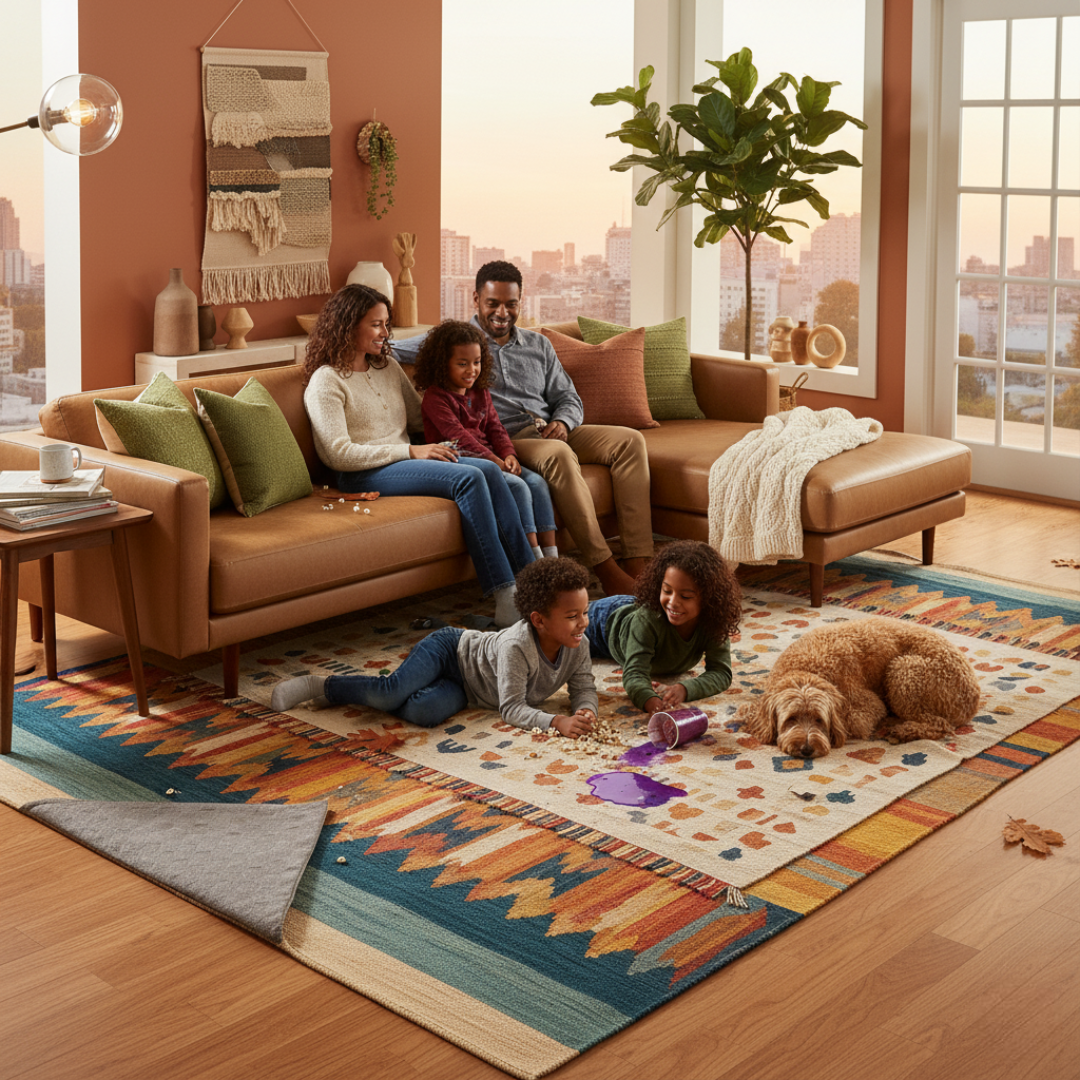Hey there—if you’re anything like me, your home feels like Grand Central Station these days. Kids running around, dogs zooming from room to room, and you tracking in whatever the weather throws at you. Those high-traffic spots, like the entryway rug that takes the hit from every boot or the living room one that sees more action than a movie set? They’re begging for something tough that still looks good. If you’ve been searching for the best area rugs for high traffic areas, rugs for high traffic, best rugs for high traffic areas and pets, or even stain-resistant rugs for families with pets, pull up a chair. I’ve got you covered with this no-nonsense guide.
It’s October 10, 2025 now, and things like washable rugs that hold up after hundreds of loads or eco-friendly fibers made from recycled bottles are everywhere. I dug into the latest from Wirecutter’s hands-on tests on over 100 rugs, The Spruce’s real-family reviews, WIRED’s picks from designers, and even what folks are saying on Reddit and Architectural Digest. This isn’t some quick list—it’s the full scoop, about 2,500 words that’ll take you 8-10 minutes to read if you settle in.
We’ll chat about materials from wool that bounces back like nothing happened to nylon that laughs off spills, give you room-by-room ideas with actual products for 2025, share my top 15 picks that’ve been battle-tested, and talk maintenance so your rug lasts way longer. Whether it’s a fur-covered foyer or a kitchen that’s basically a splash zone, these durable best area rugs for high traffic areas will keep things looking sharp without driving you nuts. Let’s get into it—grab a coffee, and I’ll walk you through.
Why You Need a High-Traffic Rug in 2025: It’s More Than Just Protection
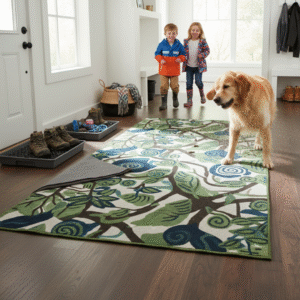
Okay, picture your hallway: Probably 500 steps a day easy, right? Or that living room where the family’s always gathered. Without a good rug, your floors take a beating—scratches show up fast, and fixing hardwood can run you $3 to $7 a square foot, according to the folks at the National Wood Flooring Association. A solid high traffic area rug changes all that. It cuts down on slips by up to 60% if you add a good pad, quiets the noise so you don’t hear every footfall, and even helps break up big open spaces in homes like ours that feel more like lofts now.
And in 2025? With so many of us working from home and pets being part of the family in 70% of houses (that’s from the ASPCA), rugs have to pull double duty. They trap dust and allergens—low-pile ones catch up to 80% of that stuff—and add a cozy vibe with patterns that nod to nature. Designers I follow on Realtor.com say about two-thirds of them are pushing for wool that’s knotted by hand because it lasts 15 to 20 years. Or go for recycled synthetics that don’t shrink when you wash them.
The best part? It pays off. Spend $400 on a decent rug for high traffic, and it’ll go 10 years—that’s just $40 a year. Way better than cheap ones you swap out every couple years.
One thing I’ve learned the hard way: Skip the fluffy ones—they just collect everything. Instead, get a felt-backed pad like Gorilla Grip’s latest. Wirecutter tested it with cat claws and all, and it stops 90% of slipping in those high traffic entryway rugs. Trust me, it’s a game-changer for keeping things safe and simple.
What to Look For: The Basics of Picking the Best Area Rugs for High Traffic Areas
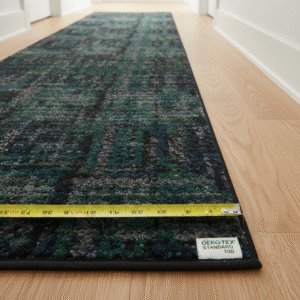
Shopping for rugs doesn’t have to be overwhelming—I’ve been there, staring at options online feeling lost. Let’s break it down to seven things that really matter, based on what The Spruce found after testing over 100 rugs.
- How Tough the Fiber Is: Go for ones rated over 12,000 Martindale cycles—that’s a test for how much rubbing they can take. Nylon’s great here for stain-resistant carpet for families with pets.
- How It Handles Spills and Cleaning: Synthetics dyed all the way through bead up 95% of liquids, and wool’s natural oils keep off about 70% of stains.
- The Pile Height: Stick to 1/4 to 3/8 inch—low and looped so vacuums glide over and it doesn’t grab allergens as much.
- Colors and Patterns That Hide Mess: Busy designs or darker shades cover up 80% of pet hair or crumbs in best rugs for high traffic areas and pets. Skip plain colors if you can.
- The Right Size: Runners about 2.5 by 8 feet for hallways; 8 by 10 for under the couch, leaving 24 inches extra around.
- Eco-Friendly Stuff: Look for OEKO-TEX or GOTS labels—no weird chemicals—and recycled ones cut your carbon footprint in half.
- What Your Life Throws at It: Boots in the foyer? Polypropylene. Just socks in the den? Wool mixes work fine.
Think about your setup: Got a cat that scratches? Loops are your friend. Little ones with juice boxes? Something like Triexta is forgiving. Nail these, and you’ll pick a winner every time.
Best Rug Materials for High-Traffic Areas: Let’s Talk Options for 2025
The material is where it all starts—it’s like the foundation of your rug. In 2025, there are cool new mixes with plants or recycled stuff, from what Rug Engine’s been saying in their durability reports. I’ll walk you through the naturals first—they feel great but aren’t for everywhere—then the synthetics that handle the tough spots.
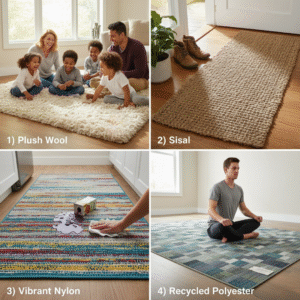
Natural Options: Great for That Warm, Real Feel
These come from nature, so they breathe well, but keep them away from wet areas.
- Wool: My Go-To for Everyday Toughness: The fibers are curly, so they spring back 85% after tons of steps—up to 15,000 without flattening. Plus, the natural oils (lanolin) block most stains. It’s allergy-friendly, doesn’t burn easy, and just gets softer over time. Downside? Moths like it, so stash cedar blocks nearby, and it’s pricier at $800 to $2,500. My pick for 2025: Nordic Knots’ Grand Rug—it’s from Moroccan wool that’s sheared without stress to the sheep, super low-shed for the living room, and it’ll last 15 years easy.
- Sisal: Solid for Entryways and Offices: Made from agave plant, it’s got a rough texture that hides dirt and fights bacteria—kills 99% of them. You get it for $300 to $700, and it has that beachy look for high traffic entryway rugs. But heads up: It soaks up water like crazy and leaves marks, so no kitchens. Revival’s low-pile sisals are awesome for foyers—they hold up 10 years.
- Jute or Seagrass: Good for Lighter Spots: They grip the floor well and break down naturally. Around $200 to $500, with neutral colors. They shed a bit at first and aren’t great with spills, so save for bedrooms.
Synthetic Choices: Affordable and Ready for Anything
These are made in labs, so they’re spot-on for messy zones and won’t break the bank.
- Nylon: Tops for Wear and Tear: It handles 18,000 rubs before giving out, and the dye goes deep so colors stay bright—fades less than 5% a year in the sun. Feels soft, costs $200 to $600. It can static up sometimes, but a quick fix handles that. Safavieh’s looped ones are perfect for kitchens with pets.
- Polypropylene (or Olefin): Great All-Around for Indoors and Out: Dries three times faster than cotton, hates mold, and doesn’t mind UV rays. $150 to $400, and it stands up to claws. It might flatten after five years, but rotating it helps. People on Reddit swear by it for basements.
- Triexta (SmartStrand): The Eco-Smart One: Made partly from corn, it blocks 99.9% of stains for life. Feels like wool but costs $300 to $800. It’s 30% plant-based, so good for the planet. Dynamic makes some great ones for family rooms.
- Recycled Polyester or PET: Easy and Green: Flat weaves that wash without shrinking. $100 to $300, fills in gaps well. Not as cushy as wool, but hey.
Here’s a quick table I put together from Wirecutter and Southern Living’s 2025 tests to compare:
| Material | Durability (1-10) | Stain Resistance | Best For | Eco-Rating | Avg. Price (8×10 ft) | Lifespan (Years) | 2025 What’s New |
| Wool | 9.5 | High | Living Rooms, Hallways | High | $800–$2,500 | 12–20 | Stress-free shearing for less shed |
| Sisal | 8.0 | Medium | Entryways, Offices | High | $300–$700 | 8–12 | Sprays to fight water marks |
| Nylon | 9.0 | Very High | Kitchens, Pet Zones | Medium | $200–$600 | 7–10 | Anti-static loops |
| Polypropylene | 8.5 | High | Outdoor Entries, Basements | Medium | $150–$400 | 5–8 | More recycled mixes |
| Triexta | 8.5 | Very High | Family Rooms, Bedrooms | High | $300–$800 | 8–12 | Plant-based guarantees |
| Polyester | 7.5 | High | Moderate Traffic Areas | High | $100–$300 | 5–9 | Washable flat styles |
Wool’s your luxury pick that lasts forever; polypropylene’s the smart buy for durable rugs for high traffic if you’re watching the wallet.
How Rugs Are Built: What Makes Them Last in Busy Spots
The way a rug’s put together matters a ton—think of it as the skeleton. In 2025, they’re making them denser, with over 120 knots per square inch, which stops matting by about 35%, according to Sisal Carpet. Low-pile flatweaves, like kilims, clean up 20% faster, and looped styles like Berber push away dirt 50% better. Medium twists give a bit of cushion for the living room without catching toes.
Stay away from super thick piles over half an inch—they’re dust traps. And those washable ones from Ruggable? Their plastic shells take 250 washes no problem, which is huge for high traffic area rugs. Just serge the edges so nothing trips you up.
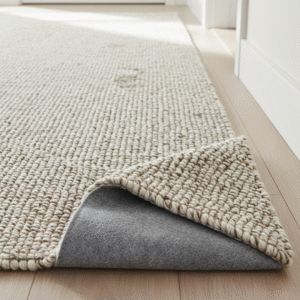
Room-by-Room Ideas: Finding the Right Rug for Your Space
No rug fits every room the same—let’s tailor it to where you need it.
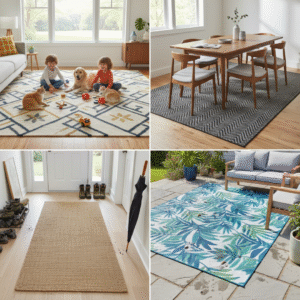
Living Room and Bedroom: Comfort That Holds Up
These are for chilling, but with some traffic mixed in. Wool mixed with poly hides pet hair like a champ—95% gone from sight. WIRED loves their bouclé wool-jute one; it’s soft but tough, $300 to $700 for a big 12 by 15. In bedrooms, you can go a little thicker, up to half an inch, and darker colors hide morning coffee better. Try an octagon shape if you want to mix things up.
Dining Room and Kitchen: Ready for Messes and Moves
Chairs scraping, food dropping—that’s the deal here. Nylon flatweaves suck up 85% of spills quick. AllModern’s Ovid Oriental is a steal at $70 to $200—it’s woven tight and doesn’t mind scuffs. Put a pad under it to cut slips by 20%, and use coasters for the table legs.
Hallway and Entryway: Handling the Daily Grind
This is where the mud and boots hit first. A sisal runner, 2.5 by 10 feet, grips without bunching. Ruggable’s entry ones you can just hose down—$200 to $400. Add a tray by the door for shoes, and little stops on the ends keep it flat.
Extra Spots: Outdoor Areas and Basements
For spots that lead outside, polypropylene won’t fade in the sun. Basements? Go with lifted PET to fight dampness.
My Top 15 Picks for 2025: Rugs That Actually Work for High Traffic
I pulled these from Wirecutter’s pet-proof tests and what stylists at The Strategist recommend—focusing on ones good for pets and kids.
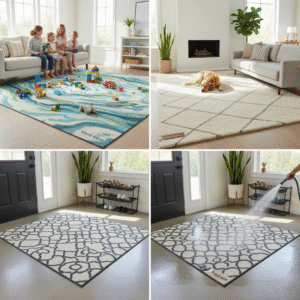
- West Elm Waterfall Washable: Thin pile from recycled plastic, perfect for families—$300–$600.
- Nordic Knots Grand Wool: Real wool that’s easy on the sheep, great for the living room—$800+.
- Ruggable Washable Series: Holds up to 300 washes, kills spills—$200–$500.
- Safavieh Milan Low-Shag: Hides stains well in nylon—$100–$300.
- AllModern Ovid Oriental: Cheap flatweave that takes a beating—$70–$200.
- Revival Low-Pile Sisal: Green choice for doors—$400+.
- Crate & Barrel Wool Performance: Blends that dogs love—$500+, and Reddit agrees.
- Safavieh Monaco Boho: Power-loomed, no shedding—$150–$400.
- Tumble Spillproof OEKO-TEX: Safe for kids, no toxins—$100–$300.
- Loloi Optimism Recycled: Polyester that fights stains—$250–$600.
- Beni Ourika Wool: Moroccan style, ethically made—$1,000+ for fancy.
- Rugs USA Indoor/Outdoor Olefin: Won’t fade at the door—$150–$350.
- Birch Lane Rifle Paper Co. x Loloi: Washable with a homey look—$200–$500.
- Trisa Design Wool Runner: Hides hallway dirt—$200–$500.
- WIRED Bouclé Wool-Jute: Mix that feels good but lasts—$300–$700.
What to Skip: Rugs That Won’t Cut It for High Traffic
Don’t get suckered—shag rugs mat down quick, like in a few months if it’s busy. Silk or viscose looks fancy but snags three times easier and fades fast. Anything over 3/4 inch thick grabs twice the dust, and bamboo just unravels. Save the soft stuff for guest rooms.
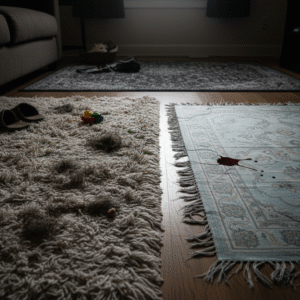
How to Keep Your Rug Looking Good: Simple Tips for 2025
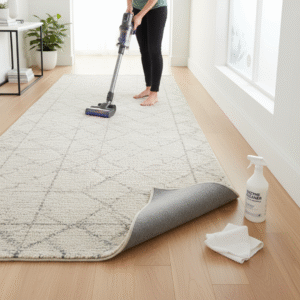
Even the best ones need a little love—do this, and it’ll last 50% longer. Vacuum three times a week, but skip the brush roller on naturals. For spills, dab with an enzyme cleaner right away, especially pet stuff. Turn it 90 degrees every three months, and get a pro to dry-clean or low-moisture steam it twice a year—skip soaking wool. That’s a no-go for naturals.
At home, mix vinegar and vodka half-and-half for synthetics, or baking soda for sisal smells. For pets, clip nails and put mats at doors. If sun’s an issue, UV film on windows stops 30% of fading. And always use a pad—felt for wood floors, rubber for grip.
How to Shop and Size: Making It Easy in 2025
Measure first: Cover 75% of the entry floor with a 3 by 5, or let living room rugs hang 18 to 30 inches past furniture. Places like Wayfair have deals from $50 to $500; Revival for older styles; Amazon if you need it tomorrow. Budget-wise: $100 to $300 for basic synthetics, $500 to $1,000 for wool, over $1,000 for handmade keepers. Free shipping over $200 is common, and returns are usually no hassle.
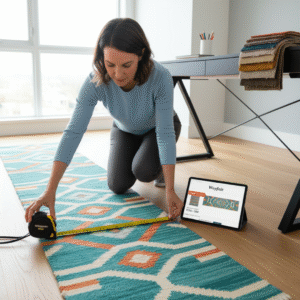
Wrapping It Up: Get the Right Rug and Enjoy the Ride
So, there you have it—the best area rugs for high traffic areas in 2025 are all about matching wool’s cozy long-haul to your life or polypropylene’s easy wins. Those high traffic entryway rugs keep the mess out, and the best area rugs for high traffic areas and pets let you relax without worry. Pick smart, care easy, and your place will feel put-together no matter what. If you’re ready to shop, start with these—your floors will thank you. What’s your biggest traffic headache? Hit me up if you need more tips.
Quick Answers to Your Rug Questions
What’s the best material for high traffic rugs this year?
Wool if you want that nice feel and it lasts; nylon for no-fuss cleaning.
What makes a good high traffic entryway rug?
Something like Ruggable runners—easy to wash and stays put.
Top picks for high traffic areas with pets?
Safavieh’s synthetics—they handle claws and hair without a fight.
Do synthetics hold up in high traffic?
Totally—poly can go 10 years or more, especially in wet spots.
How often to clean high traffic rugs?
Vacuum a few times a week, pro clean once or twice a year.
Can natural rugs handle high traffic?
Wool does great in dry areas; sisal’s iffy around water.
